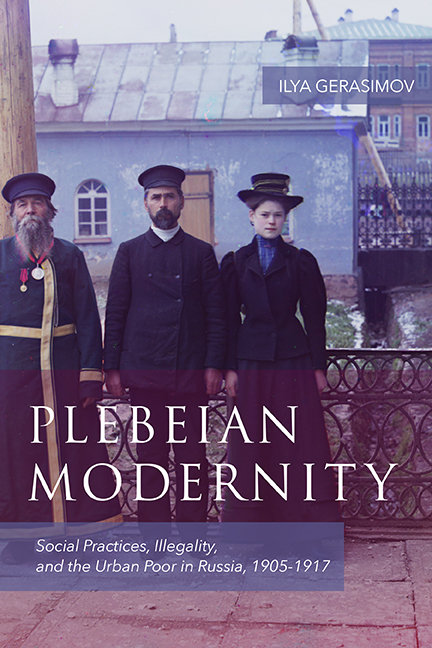Book contents
- Frontmatter
- Contents
- Acknowledgments
- Note on Editorial Conventions
- Introduction: The Subalterns Speak Out: Gerasim and the Infamous
- 1 Writing Degree Zero, and Beyond: Reading Social Practices between the Lines
- 2 The Middle Volga City as the Middle Ground: Urban Plebeian Society
- 3 The Patriarchal Metropolis: Trespassing Social Barriers in Late Imperial Vilna
- 4 “We Only Kill Each Other”: The Anthropology of Deadly Violence and Contested Intergroup Boundaries
- 5 The Transformative Social Experience of Illegality
- Epilogue: Gerasim in Power: A Plebeian Modernity
- Notes
- Selected Bibliography
- Index
Epilogue: Gerasim in Power: A Plebeian Modernity
Published online by Cambridge University Press: 09 June 2021
- Frontmatter
- Contents
- Acknowledgments
- Note on Editorial Conventions
- Introduction: The Subalterns Speak Out: Gerasim and the Infamous
- 1 Writing Degree Zero, and Beyond: Reading Social Practices between the Lines
- 2 The Middle Volga City as the Middle Ground: Urban Plebeian Society
- 3 The Patriarchal Metropolis: Trespassing Social Barriers in Late Imperial Vilna
- 4 “We Only Kill Each Other”: The Anthropology of Deadly Violence and Contested Intergroup Boundaries
- 5 The Transformative Social Experience of Illegality
- Epilogue: Gerasim in Power: A Plebeian Modernity
- Notes
- Selected Bibliography
- Index
Summary
This book has told a story of plebeian society in four cities of the Russian Empire during the interrevolutionary period of 1906–16. The story has had to be reconstructed mostly from the actions and gestures of the members of plebeian society, who expressed themselves more accurately in social practices than in written or even spoken words. To their educated contemporaries, who perceived reality through textual representations, as well as to modern historians looking for textual primary sources, those people in many ways seem analogous to deaf nonspeakers. Like the protagonist of the 1852 novella Mumu by the Russian classic writer Ivan Turgenev, the deaf and nonspeaking serf Gerasim, members of late imperial urban plebeian society could not communicate their experiences and formulate their attitudes even to each other in the same way as participants in the elite public sphere. Of course, they were not completely aphasiac: as we have seen in the previous pages, they were capable of emulating popular tropes and applying them rationally, or could themselves become objects of discursive manipulations. Still, this was not their preferred form of communication or one that they really trusted. It was not theirs almost by definition because it was developed and sustained by a different social stratum: the patricians of the middle class, the primary agents of the public sphere. Even the notion of “them” as a group is the hypothesis of a modern historian as an outside observer of their shared social practices and way of life because these people themselves did not produce self-descriptive narratives of their unity or assume a common name.
It is amazing that members of a socially diverse plebeian society, living lives “beneath any discourse” (Foucault), succeeded in integrating innumerable pockets of local knowledge and particularist experience into a common social sphere that revealed certain structural similarities in Kazan, Odessa, Nizhny Novgorod, and Vilna. This became possible because the common plebeian social sphere was coordinated and communicated through the medium of a specific common language of social practices. One of the main social practices that helped to integrate individual experiences and distinctive pockets of local knowledge into a single social sphere can be called the middle ground.
- Type
- Chapter
- Information
- Plebeian ModernitySocial Practices, Illegality, and the Urban Poor in Russia, 1906–1916, pp. 171 - 192Publisher: Boydell & BrewerPrint publication year: 2018

